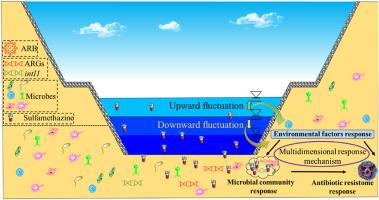Multidimensional response mechanism of sulfamethazine migration and antibiotic resistome spread in natural riverbed driven by vertical river water level fluctuations
IF 7.3
2区 环境科学与生态学
Q1 ENVIRONMENTAL SCIENCES
引用次数: 0
Abstract
In order to elucidate the multidimensional response mechanism for migration of antibiotics and spread of resistome in riverbed driven by river water level fluctuations, dynamic reactors were set up to simulate the variation of sulfamethazine vertical migration, biotransformation and resistance genes expression according to fluctuation direction and magnitude. The upward fluctuation of water level accelerated the migration rate of sulfamethazine with a water-head driven impact index of 2.61 cm/(d•m). However, the downward fluctuation reduced the migration rate from 0.0168 to 0.0103 cm/m on spatial scales and 0.0961 to 0.0241 cm/d at time series, and 27.2% accumulative sulfamethazine was decomposed. The annual accumulation of sulfamethazine in pore water and soil attained 148.24 μg/L and 4.73 μg/g. Water level fluctuations also influenced sulfamethazine degradation rate without changing the metabolic pathways via hydrolysis and oxidative due to the rupture between sulfonamide linked cyclic functional groups with the function of functional genes. However, upward water level decreased 5.26%-8.95% of metabolic functional genes Sad A/B and dmpL and enhanced the resistance genes expression levels of sul1, sul2, and intI1 with 70.03, 59.11, and 177.9 copies/mL, which accelerated the accumulation antibiotics and antibiotics resistance bacteria (ARB). Furthermore, a multidimensional risk assessment framework based on machine learning was developed to quantify resistome spread risk, revealing a 5.69% increase in overall resistome-associated environmental risk, which was predominantly classified as medium to high. This spread trend of antibiotic resistome presented multidimensional response with environmental factors in order of DO> ORP> TOC due to water level fluctuations.

河流垂直水位波动驱动的天然河床磺胺乙胺迁移和抗生素抵抗组传播的多维响应机制
为了阐明河流水位波动驱动抗生素在河床迁移和抗性组传播的多维响应机制,建立动态反应器,模拟磺胺乙嗪垂直迁移、生物转化和抗性基因表达随波动方向和幅度的变化。水位向上波动加速了磺胺乙胺的迁移速率,水头驱动影响指数为2.61 cm/(d•m)。而向下的波动使空间尺度上的迁移速率从0.0168 ~ 0.0103 cm/m,时间序列上的迁移速率从0.0961 ~ 0.0241 cm/d,累计分解了27.2%的磺胺乙烷。孔隙水和土壤中磺胺乙胺的年累积量分别为148.24 μg/L和4.73 μg/g。水位波动也影响了磺胺乙烷的降解速率,但没有改变其水解和氧化的代谢途径,这是由于磺胺连接的环官能团与功能基因之间的断裂。升高水位使代谢功能基因Sad A/B和dmpL的表达量降低5.26% ~ 8.95%,sul1、sul2和intI1抗性基因的表达量分别为70.03、59.11和177.9拷贝/mL,加速了抗生素和抗生素耐药菌(ARB)的积累。此外,研究人员还开发了一个基于机器学习的多维风险评估框架来量化抗阻体传播风险,结果显示,抗阻体相关的总体环境风险增加了5.69%,主要被分类为中至高。由于水位波动,抗生素耐药性组的传播趋势与环境因素呈多维响应关系,依次为DO>; ORP>; TOC。
本文章由计算机程序翻译,如有差异,请以英文原文为准。
求助全文
约1分钟内获得全文
求助全文
来源期刊

Environmental Pollution
环境科学-环境科学
CiteScore
16.00
自引率
6.70%
发文量
2082
审稿时长
2.9 months
期刊介绍:
Environmental Pollution is an international peer-reviewed journal that publishes high-quality research papers and review articles covering all aspects of environmental pollution and its impacts on ecosystems and human health.
Subject areas include, but are not limited to:
• Sources and occurrences of pollutants that are clearly defined and measured in environmental compartments, food and food-related items, and human bodies;
• Interlinks between contaminant exposure and biological, ecological, and human health effects, including those of climate change;
• Contaminants of emerging concerns (including but not limited to antibiotic resistant microorganisms or genes, microplastics/nanoplastics, electronic wastes, light, and noise) and/or their biological, ecological, or human health effects;
• Laboratory and field studies on the remediation/mitigation of environmental pollution via new techniques and with clear links to biological, ecological, or human health effects;
• Modeling of pollution processes, patterns, or trends that is of clear environmental and/or human health interest;
• New techniques that measure and examine environmental occurrences, transport, behavior, and effects of pollutants within the environment or the laboratory, provided that they can be clearly used to address problems within regional or global environmental compartments.
 求助内容:
求助内容: 应助结果提醒方式:
应助结果提醒方式:


